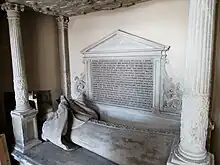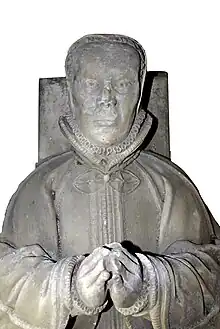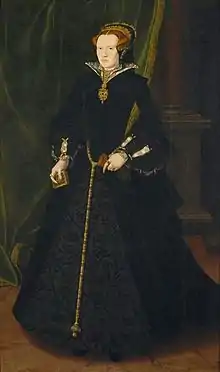Sybil Penn
Sybil or Sibel Penn (died 1562) was an English courtier. Her roles at court included nurse and teacher to Edward VI of England and Lady of the Bed Chamber to his sisters, Mary I of England and Elizabeth I of England.[1]


Family background
She was a daughter of William Hampden of the Hill and his wife Audrey Hampden, an heiress of Kimble.[2] Her aunt, Sibill Hampden, married Thomas Hawtrey, whose son William Hawtrey (died 1597), was custodian of Lady Mary Grey at Chequers in 1565.[3][4]
The genealogical detail of her family is variously reported. Her brothers were Richard Hampden of Dunton and Missenden Abbey, Clerk of the Kitchen to Elizabeth I,[5] Griffith Hampden (MP), who entertained Queen Elizabeth at Hampden House, and William Hampden, who married Elizabeth Cromwell, and was the father of John Hampden. Sybil Penn married David Penn, of Penn in Buckinghamshire.[6]
Career

Penn was appointed Mistress Nurse to Prince Edward, the son of Henry VIII and Jane Seymour, probably as a "dry nurse" in October 1538. When she was nurse to Prince Edward, according to family tradition, Henry VIII gave her a pearl necklace, which survives.[8]
Princess Mary gave a gift to the nursery staff and midwife at Edward's christening at Hampton Court (perhaps before Penn's appointment), and later gave the "Mistress Nurse" a bonnet and a length of yellow satin damask, and gilt spoons to the four ladies employed to rock the cradle.[9] Mary also gave clothes to Blanche Milborne, Lady Troy, who was in charge of Edward's care. Later, Mary gave a gold brooch depicting Saint George to the Mistress Nurse's daughter, perhaps her namesake Mary Penn.[10]

Sybil Penn wrote a letter of recommendation to Thomas Cromwell for her brother-in-law Griffith Richards (husband of Audrey Hampden), in the hope that he would also be employed in the service of Prince Edward.[11][12] She wrote to Cromwell again in 1539 or 1540, from Hunsdon House one of Edward's residences, asking for the lease of Missenden Abbey, in response to Cromwell's promise to do her "some good".[13] In 1553, Edward VI rewarded "Sibella Penne" with two manors, Aufries (Affricks) and Beamond, and other property in Little Missenden, confirming a grant of 1541, for her work as a nurse and educator.[14]
In the records of New Year's Day gifts known as "Gift Rolls", it was noted that Mrs Penn, the former nurse, gave half a dozen handkerchiefs edged with gold passamyne lace in 1556. The gift rolls also mention [Lucy Chevall] Mrs Barlee alias Penne, the widow of Henry VIII's barber John Penne, and heiress of Codicote.[15] A drawing by Hans Holbein is labelled "Mother Jak, King Edward's nurse". The identity of this person is unclear, and possibly "Mrs Jak" was a nickname for Sybil Penne or another worker in the Prince's household.[16][17] Juliana or Julian Penne, the mother of Michael Hicks and Baptist Hicks, and an active money lender in Tudor court circles, has been confused with Sybil Penne.[18]
Mary I
Sibyl Penn rode in Mary I's Royal Entry on 30 September,[19] and attended the Mary's coronation on 1 October 1553, wearing a scarlet gown furred with "lettice" fur. Other ladies and chamberers given this costume included Susan Clarencieux, Mrs Jerningham (Elizabeth Jerningham,[20] or her niece, later Mary Southwell), Mary Finch, Mistress Russell, Mistress Golborne, and Mistress Sydney (a relation or the wife of Henry Sidney). Lettice is a grey weasel fur.[21][22]
Penn also attended Mary's funeral on 14 November 1558. In the procession, she rode in a chariot or carriage with Susan Clarencieux, Mistress Tynnes, and Mistress Southwell.[23] They wore morning clothes with "barbes" (veils) under their chins.[24]
Smallpox and the Sidney connection

Sybil Penn died on 6 November 1562, probably from an outbreak of smallpox at this time. Queen Elizabeth and Mary Sidney were seriously ill but recovered.[25]
Historians seem to have been confused about Mrs Penn's identity due to letters of recommendation to Cromwell from William Sidney on behalf of members of the Sidney family hoping to serve in Edward's household.[26] Mary Sidney's husband Henry Sidney later wrote that his mother (Anne Pakenham d. 1544) had been Prince Edward's governess, a near kinswoman his nurse, and a maternal aunt had been Edward's "dry nurse", in the years when the prince "remained in woman's government" before starting with a schoolmaster.[27] Sybill Penn may have been the maternal aunt described as the "dry nurse", invited to serve in the prince's household as a connection of William Sidney.[28]
Monument at St Mary's Hampton
Penn was buried at St Mary's Hampton, Middlesex, where there is a monument. The rhyming epitaph declares, referring to the death of Jane Seymour and Penn's employment by Mary and Elizabeth, "To court she called was, to foster up a king ... Two queens that sceptre bore gave credit to this dame".[29]
Hampton Court ghost story
Sibyl Penn's monument was moved when the church was rebuilt in 1829, and this gave rise to a ghost story. It was said the noise of spinning wheel was heard at nearby Hampton Court and that soon afterwards the Board of Works found a closed-up room with a spinning wheel.[30] The story of Sybil Penn as the "Grey Lady" haunting Hampton Court continues to be told.[31]
Sybil Penn's body was not found buried under the monument in 1829, but only, according to one report, a hair-pin and some hair.[32] The body had been moved soon after burial at Hampton to the chancel of Holy Trinity, Penn, following the instructions in her husband's will.[33][34]
Family
Her children included:[35]
- John Penn, who married Ursula Walliston.[36]
- Mary Penn, who married George Peckham.[37]
- Margaret Penn, who married Thomas Gifford of Middle Claydon, her father bequeathed her the apparel worn by Sybil Penn at court.
- Edward Penn.[38]
- Thomas Penn
References
- David Loades, Mary Tudor: A Life (Oxford, 1992), p. 355.
- Ernest Law, A Short History of Hampton Court, 1 (London, 1885) p. 196 fn. citing the will of William Hampden.
- George Lipscombe, History and Antiquities of Buckinghamshire, 2 (London, 1847), pp. 193, 346
- 'HAWTREY, William (c.1520-97), of Chequers, Bucks', History of Parliament: the House of Commons 1558-1603, ed. P.W. Hasler, 1981
- George Lipscombe, History and Antiquities of Buckinghamshire, 2 (London, 1847), pp. 346, 373.
- F. Gordon Roe, 'Portrait of a Ghost, Mrs Penn: Edward VI's Foster Moster', The Connoisseur, 112 (December 1943), pp. 84–86: The visitation of the county of Buckingham made in 1634 (London, 1909), p. 97
- Portrait of Edward VI, RCIN 404441
- Diana Scarisbrick,Tudor and Jacobean Jewellery (London: Tate, 1995), p. 76: Maria Hayward, Dress at the court of Henry VIII (Maney, 2007), p. 199.
- Maria Hayward, Dress at the court of Henry VIII (Maney, 2007), p. 199: John Gough Nichols, Literary Remains of Edward VI, 1, p. xxxv fn: Privy Purse Expenses of the Princess Mary, pp. lxxx, 54, 85: John Strype, Ecclesiastical Memorials, 2 (London, 1816), p. 4.
- Frederick Madden, Privy Purse Expenses of the Princess Mary (London, 1831), pp. 54, 184
- Letters & Papers Henry VIII, 13:2, no. 1257: TNA SP 1/141 f.170.
- Mary Anne Everett Green, Letters of Royal and Illustrious Ladies of Great Britain, 3 (London, 1846), pp. 66–67.
- Letters & Papers Henry VIII, 14:2 (London, 1895), p. 372 no. 55.
- Notes & Queries, 4th series XII (16 August 1873), p. 137: Notes & Queries, 7th series X (15 November 1890), p. 383: George Lipscombe, History and Antiquities of Buckinghamshire, 2 (London, 1847), p. 395: Calendar of the Patent Rolls Preserved in the Public Record Office: 1553 (London, 1926), p. 72.
- Collection of Ordinances (London, 1790), p. 169
- Ernest Law, A Short History of Hampton Court, 1 (London, 1885) p. 196 fn: John Gough Nichols, Literary Remains of Edward VI, 1, p. xxxiii fn.
- John Nichols, Illustrations of the Manners and Expences of Antient Times in England (London, 1797), p. 9
- Alan Gordon Rae Smith, Servant of the Cecils: the life of Sir Michael Hickes (New Jersey, 1977), p. 194 no. 16.
- Mark Noble, A History of the College of Arms (London, 1805), p. 116.
- English Baronetage, vol. 1 (London, 1741), p. 456.
- Janet Arnold, 'Coronation Portrait of Queen Elizabeth I', Burlington Magazine, 120 (1978), pp. 726-741: Valerie Cumming, C. W. Cunnington, P. E. Cunnington, The Dictionary of Fashion History (Bloomsbury, 2010), p. 121: The National Archives, TNA SP 46/8 f.5., 'to ... Mrs Penne ... to everye of them, one furre of lettes for furreing everye of them one gowne of scarlett ageinste our sayde coronacion'.
- David Loades, Mary Tudor (Basil Blackwell, 1989), p. 192.
- Mark Noble, A History of the College of Arms (London, 1805), p. 117.
- Thomas Hearne, De rebus Britannicis collectanea, vol. 5 (London, 1774), p. 317
- Donald Hopkins, The Greatest Killer: Smallpox in History (University of Chicago, 2002), pp. 1–3.
- John Nichols, Literary remains of King Edward the Sixth, 1 (London, 1857), pp. xxxiii–xxxiv
- J. S. Brewer & W. Bullen, Calendar of the Carew Manuscripts preserved in the Archiepiscopal Library at Lambeth, vol. 2 (London, 1868), p. 359 no. 501: Letter from Henry Sidney, Lambeth Palace Library
- Michael G. Brennan, The Sidneys of Penshurst and the Monarchy, 1500-1700 (Ashgate, 2006), p. 20.
- Daniel Lysons, An Historical Account of Those Parishes in the County of Middlesex (London, 1830), p. 77
- Ernest Law, A Short History of Hampton Court (London, 1897) pp. 97–99.
- Andrew Griffin, 'Ghost of the Grey Lady at Hampton Court', Independent, 25 February 2015
- Ernest Law, A Short History of Hampton Court (London, 1906). p. 98
- Henry J. Lee, 'Genealogical Gleanings, Contributory to a History of the Family of Penn', Pennsylvania Magazine of History and Biography, 14 (1890), p. 55, and p.6 in offprint
- History, Monuments and Memorials of Penn
- Notes & Queries, 4th series XII (16 August 1873), p. 137.
- The visitation of the county of Buckingham made in 1634 (London, 1909), p. 98
- The visitation of the county of Buckingham made in 1634 (London, 1909), p. 98: Henry J. Lee, 'Genealogical Gleanings, Contributory to a History of the Family of Penn', Pennsylvania Magazine of History and Biography, 14 (1890), p. 55.
- Notes & Queries, 7th series X (15 November 1890), p. 383.